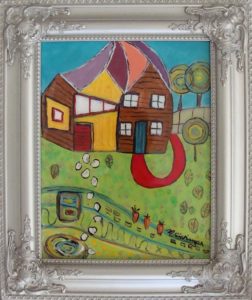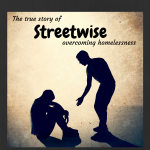
Coming Home /16” by 19” / acrylic with silver frame / $ 195
Open the door and what do you see? Is home an interesting reflection of you and do others enjoy it? Does it share your personality? Your history? Your curiosity about life?
The following excerpt is from my upcoming book Lives of Museum Junkies that is due out at the end of August. Look for information in upcoming blogs. I will be holding several book signings beginning in Tampa, Florida in September; Lansing, Michigan in October; and Portland, Oregon in November. Information will be forthcoming in the next few weeks. I look forward to seeing you at one of these events.
Home as Museum
“You can easily substitute home for museum and live in an environment made inspiring. Instead of exhibits, consider decorations, furniture and personal treasures. Architecture, use of space, selection and arrangement of furnishings, collections, and the way they are displayed all define you. How you move about your home, share treasures with friends and family, and teach your children to understand their cultural heritage becomes your way of passing on values.
Ray, my life partner, is a maker of totem poles and Northwest Coast masks. Outside of our home, there is a seventeen foot pole that has become a neighborhood marker. “Go to the totem pole and turn left,” is an oft heard direction given by acquaintances. The lower level of our house has both indoor and outdoor shop areas where carving and painting are pursued much to the enjoyment of nosey friends and those hiking an adjacent trail. Strangers who hear the tap, tap, tap of a hammer stop by wanting to know what is going on, and Ray gladly shows them his carvings, entertaining them with stories of Raven and Beaver.
Our home is filled with his carvings, my collections of pottery and masks, canvases that I paint, and art purchased while traveling. Our furnishings are arranged in a restful way, though presented as eye candy for our visitors. I enjoy living surrounded by the items Ray and I have either made or collected. Sharing them with friends lets them into our souls and initiates many conversations about culture, art, and even politics. Our friends often say when entering our home that it looks like a museum, only warmer and more welcoming.
Many children are first introduced to a cultural institution by visiting a children’s museum. These institutions are unique because the ingenuity they apply to educating the young is more than just exciting—it is engaging. Children spend hours engaged in activities such as playing in water (learning physics and hydrodynamics without realizing it), dressing up in period costumes (a study in history), constructing and plumbing buildings (engineering), and a host of other activities that involve physical as well as mental effort. Young visitors often are seen crying as their parents pull them from the building to go home. A secret to their success is that they are centered on the child and organize their spaces in a way that permits freedom of movement. Displays are built to withstand hard use. They encourage learning by using a variety of cleverly hidden techniques.
I encourage parents to think like a professional and start their own museum at home. What better place to inspire your own child than the relaxed environment of a play area or living room? According to The American Association of Children’s Museums, “A children’s museum is defined as an institution committed to serving the needs and interests of children by providing exhibits and programs that stimulate curiosity and motivate learning.” They encourage parents to interact with their children while in the museum in order to make the experience more meaningful.
That definition fit my family to a “T.” When we moved to Lexington, Massachusetts, a community without a hands-on museum, I decided that I could make my own home into one. The Boston Children’s Museum was much too far to travel to on a regular basis. Part of the challenge of my home operation was one of organization. I decided to set up my children’s basement playroom with a Montessori approach.”
_____________
Lives of Museum Junkies offers insight into how I went about doing this on a shoestring. I also encourage grandparents to consider their residences as their private museum. The accumulations from a life time of travel and just plain living can be organized and displayed in such a way as to fascinate friends and family alike. Perhaps you have thought similarly and share your treasures in a unique way. Do share on my blog site, eichingerfineart.com/blog.
_______________
Artwork is always for sale. Contact me at marilynne@eichingerfineart.com.
________________
For sale on Amazon by Marilynne Eichinger: The True Story of Streetwise, overcoming homelessness and beating the odds. Go to AMAZON .

Home » Blog » Home as Museum
Table of Contents
Coming Home /16” by 19” / acrylic with silver frame / $ 195
Open the door and what do you see? Is home an interesting reflection of you and do others enjoy it? Does it share your personality? Your history? Your curiosity about life?
The following excerpt is from my upcoming book Lives of Museum Junkies that is due out at the end of August. Look for information in upcoming blogs. I will be holding several book signings beginning in Tampa, Florida in September; Lansing, Michigan in October; and Portland, Oregon in November. Information will be forthcoming in the next few weeks. I look forward to seeing you at one of these events.
Home as Museum
“You can easily substitute home for museum and live in an environment made inspiring. Instead of exhibits, consider decorations, furniture and personal treasures. Architecture, use of space, selection and arrangement of furnishings, collections, and the way they are displayed all define you. How you move about your home, share treasures with friends and family, and teach your children to understand their cultural heritage becomes your way of passing on values.
Ray, my life partner, is a maker of totem poles and Northwest Coast masks. Outside of our home, there is a seventeen foot pole that has become a neighborhood marker. “Go to the totem pole and turn left,” is an oft heard direction given by acquaintances. The lower level of our house has both indoor and outdoor shop areas where carving and painting are pursued much to the enjoyment of nosey friends and those hiking an adjacent trail. Strangers who hear the tap, tap, tap of a hammer stop by wanting to know what is going on, and Ray gladly shows them his carvings, entertaining them with stories of Raven and Beaver.
Our home is filled with his carvings, my collections of pottery and masks, canvases that I paint, and art purchased while traveling. Our furnishings are arranged in a restful way, though presented as eye candy for our visitors. I enjoy living surrounded by the items Ray and I have either made or collected. Sharing them with friends lets them into our souls and initiates many conversations about culture, art, and even politics. Our friends often say when entering our home that it looks like a museum, only warmer and more welcoming.
Many children are first introduced to a cultural institution by visiting a children’s museum. These institutions are unique because the ingenuity they apply to educating the young is more than just exciting—it is engaging. Children spend hours engaged in activities such as playing in water (learning physics and hydrodynamics without realizing it), dressing up in period costumes (a study in history), constructing and plumbing buildings (engineering), and a host of other activities that involve physical as well as mental effort. Young visitors often are seen crying as their parents pull them from the building to go home. A secret to their success is that they are centered on the child and organize their spaces in a way that permits freedom of movement. Displays are built to withstand hard use. They encourage learning by using a variety of cleverly hidden techniques.
I encourage parents to think like a professional and start their own museum at home. What better place to inspire your own child than the relaxed environment of a play area or living room? According to The American Association of Children’s Museums, “A children’s museum is defined as an institution committed to serving the needs and interests of children by providing exhibits and programs that stimulate curiosity and motivate learning.” They encourage parents to interact with their children while in the museum in order to make the experience more meaningful.
That definition fit my family to a “T.” When we moved to Lexington, Massachusetts, a community without a hands-on museum, I decided that I could make my own home into one. The Boston Children’s Museum was much too far to travel to on a regular basis. Part of the challenge of my home operation was one of organization. I decided to set up my children’s basement playroom with a Montessori approach.”
_____________
Lives of Museum Junkies offers insight into how I went about doing this on a shoestring. I also encourage grandparents to consider their residences as their private museum. The accumulations from a life time of travel and just plain living can be organized and displayed in such a way as to fascinate friends and family alike. Perhaps you have thought similarly and share your treasures in a unique way. Do share on my blog site, eichingerfineart.com/blog.
_______________
Artwork is always for sale. Contact me at marilynne@eichingerfineart.com.
________________
For sale on Amazon by Marilynne Eichinger: The True Story of Streetwise, overcoming homelessness and beating the odds. Go to AMAZON .
Table of Contents